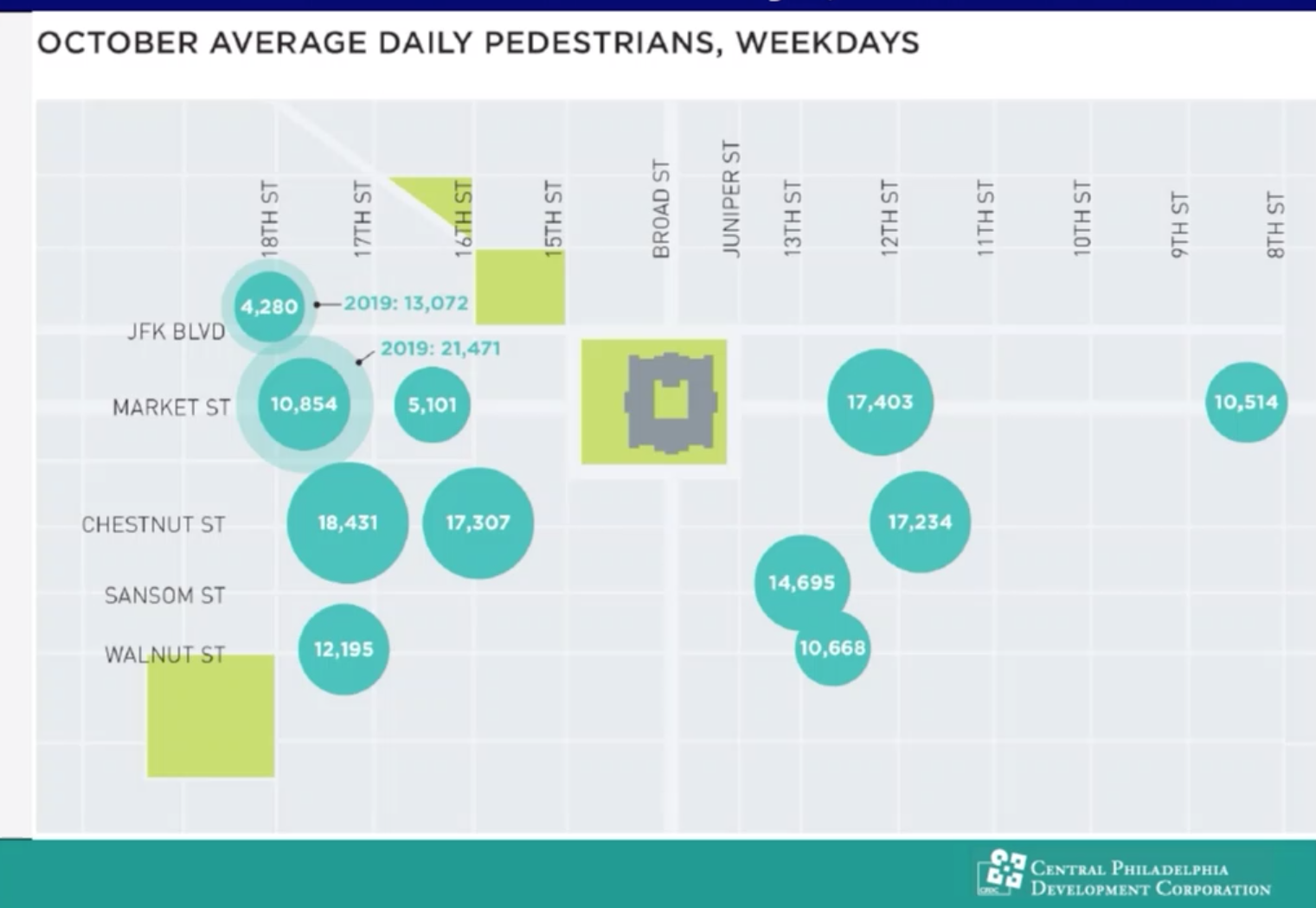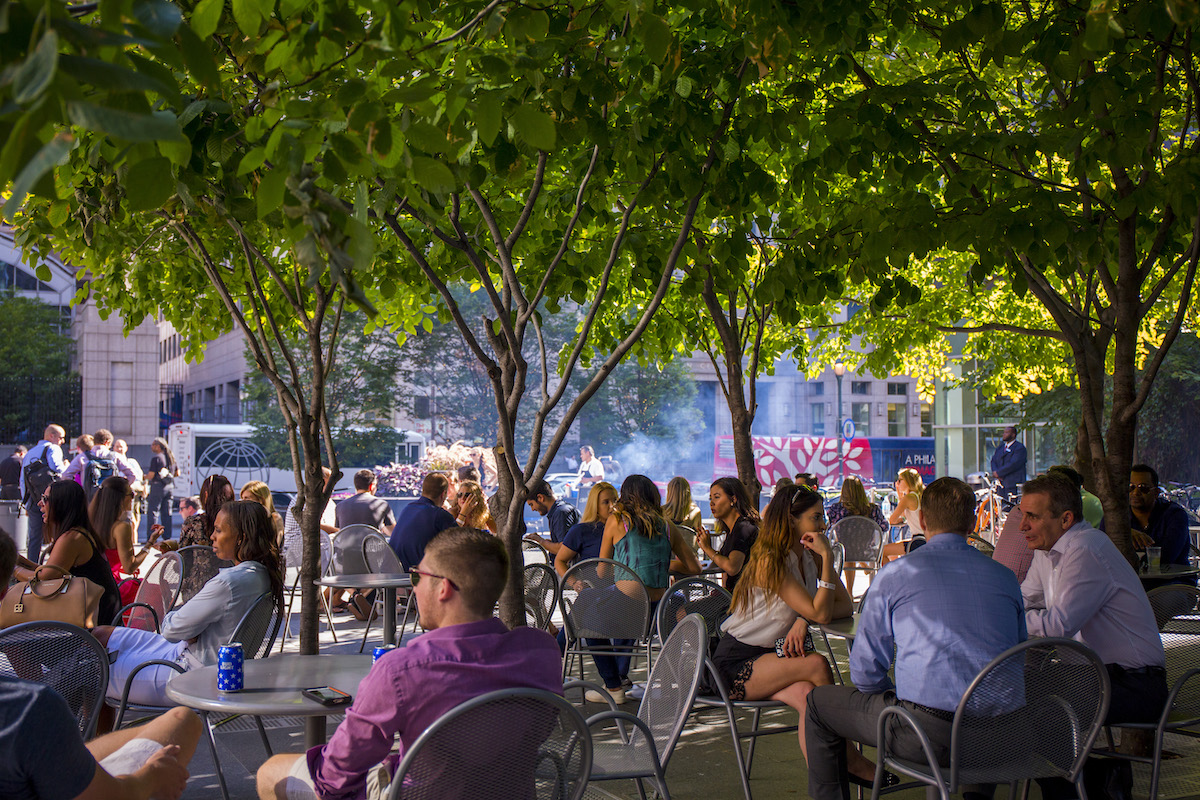While foot traffic from residents and visitors is seeing a healthy recovery from its lows during the height of the COVID-19 pandemic, office buildings are still notably pretty vacant. Those effects can be felt across retail, restaurants and hospitality sectors.
The Central Philadelphia Development Corporation hosted a discussion Tuesday on how the city is operating in this stage of the pandemic when vaccines are plentiful, but cases continue to ebb and flow. Paul Levy, president and CEO of the Center City District; Joel Dales, the deputy commissioner of the Philadelphia Police Department; and Jody Holton, SEPTA’s assistant GM of planning and strategic initiatives, shared what they’ve seen at their respective agencies.
The city is still not seeing the same number of workers, residents or visitors in its downtown core compared to before the pandemic, Levy said. Earlier this year, data based on pedestrian volumes at 20 locations throughout the core of Center City showed daily averages rose to 103,296 people in April, up from 91,574 people a day downtown in October 2020.
By October 2021, downtown saw nearly 150,000 daily pedestrians, some of the highest numbers since the pandemic began. But where those pedestrians are spending time shows a picture.

Daily pedestrians in October 2021. (Image via CPDC)
Retail corridors along Chestnut, Walnut and Sansom streets saw a return to semi-normal levels with people visiting shops and restaurants, but Market Street and JFK Boulevard — where many of Center City’s office buildings are clustered — did not see the same return. Those areas are experiencing about half of the visitors as 2019 levels.
Levy told attendees that while vaccines have allowed companies to call their employees back to work, occupancy levels at office buildings in Center City are currently at about 30% to 40% of their pre-pandemic levels. Before 2020, buildings saw about an 11% vacancy rate, but that is about 18.5% today, he said.
“Those in buildings right now are the people who can’t work remotely,” Levy said.
Outside of Center City, in neighboring areas like Northern Liberties or Queen Village, restaurants and retail stores are operating at about 81% of their taxable revenue, pointing to people spending their money closer to home than downtown.
Holton said that while SEPTA ridership is still down from its pre-pandemic rates, it’s increasing. The agency has upped its cleaning protocols, and its air circulation system ensures clean air on vehicles every two to three minutes. There have been no linked outbreaks to ridership, and its use will play a large role in returning to offices, she said.
There are many factors at play, Levy said, but a safe return to offices will play a role in the city’s economic stability as we learn to live with COVID-19.
“If you walk around Center City and peep into bars and restaurants, you will find people are not afraid to be there,” Levy said. “So what’s the hesitation with offices? Social distancing is easy to achieve and suffice it to say, if we want a competitive city that works on reducing poverty, it’s time to get office workers back in the office.”
Before you go...
Please consider supporting Technical.ly to keep our independent journalism strong. Unlike most business-focused media outlets, we don’t have a paywall. Instead, we count on your personal and organizational support.
3 ways to support our work:- Contribute to the Journalism Fund. Charitable giving ensures our information remains free and accessible for residents to discover workforce programs and entrepreneurship pathways. This includes philanthropic grants and individual tax-deductible donations from readers like you.
- Use our Preferred Partners. Our directory of vetted providers offers high-quality recommendations for services our readers need, and each referral supports our journalism.
- Use our services. If you need entrepreneurs and tech leaders to buy your services, are seeking technologists to hire or want more professionals to know about your ecosystem, Technical.ly has the biggest and most engaged audience in the mid-Atlantic. We help companies tell their stories and answer big questions to meet and serve our community.
Join our growing Slack community
Join 5,000 tech professionals and entrepreneurs in our community Slack today!

The person charged in the UnitedHealthcare CEO shooting had a ton of tech connections

From rejection to innovation: How I built a tool to beat AI hiring algorithms at their own game

Where are the country’s most vibrant tech and startup communities?



